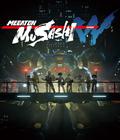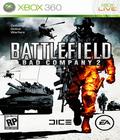Sometime in the near future, Russia and the United States go to war.
This has been something of a running theme for several recent titles, such as Infinity Ward's fiery Cold War fantasy in Modern Warfare 2, InnoGlow's Panzers: Cold War and Massive Entertainment's sweeping World War III RTS, World in Conflict. Unless you've played the first game, the reasons behind the Russian Bear deciding to take a bite out of the world aren't entirely clear in Battlefield: Bad Company 2. Even then, a refresher course would have helped to give the story some legs from the start.
If you haven't played through the first Bad Company, the reason for Russia's fury might have something to do with a certain unauthorized invasion of a neutral country by a squad of soldiers during its pursuit of gold bars. It seems that the Russians didn't take too kindly to the damage that the soldiers did during their slapstick chase in Russia's backyard in the first game. This time around, Bad Company 2 confines most of the craziness to the character dialogue, and it's only one of several welcome changes that the designers have made.
Bad Company 2 follows B Company's continuing tour of duty as the war between the Russian Federation and the U.S. continues to burn across borders. The reason they call them "Bad Company" is because it's the home of those with whom the Army has lost its patience for any number of reasons, and it's a useful group to send out on suicide missions. It's the pit stop to a dishonorable discharge in one way or another, but even after B Company's destructive tendencies in the prior game, the Army has apparently held on to them for a while longer.
There's Haggard, the explosives expert from Texas and a die-hard Dallas Cowboys fan. Sweetwater has the smarts and the mouth to go with it. Sarge is the professional glue holding the company together and is just inches away from a much-deserved retirement. The player sees the story through the eyes of young, but not quite hardened, Preston Marlowe. It's a buddy story filled with plenty of humor from the characters as they chew the fat on conspiracies and whatever else is on their minds in between firefights.
Although the story does a poor job of explaining the world war, the characters bring out plenty of amusing personality during every mission. The title also manages to squeeze a sense of mystery from its material but then squanders by what follows, leaving the rest of the story feeling flat. It's still more cohesive than, say, Modern Warfare 2's take on "Red Dawn," but at the same time, it comes with quite a few clichés, including a requisite "don't give up the fight" moment when everyone decides to throw in the towel for an ill-timed moment of gravitas.
While Haggard won't run into another nation at the mention of gold, DICE has also made it return closer to home, beginning with the first mission. It acts as both a tutorial and as a creative twist on history that is also a clever homage to the series' roots. For fans like myself who remember its debut on PCs, this is something of a nostalgic homecoming before bringing me back to the present with the deep green jungles, dry deserts and frosty mountain heights of South America. There are no fake nations here, either, although the thin story focuses more on its characters than a plot, thus creating the odd sense that the countries in which most of the game takes place are simply hosts to the widespread demolition work.
Not a stage will go by without something exploding and DICE's improvements to their Frostbite engine beautifully paints the action with a detailed digital brush for those sets that can appreciate it. Jungles devolve into green hells as quickly as I squeezed the trigger and I could almost feel my eyeballs drying from staring at the open vastness of the Atacama Desert. The visuals are simply stunning, especially online where none of that fidelity is lost among any of its maps. Each weapon rips the air apart as much as they did in the first game which had already won me over with the attention paid to its indoor and outdoor effects. Rooms become echo chambers to every shot and I could even hear the crack of burst gunfire echoing in the backdrop during a lull in the fights outside.
The colossal scale of each map easily allows you to experiment with different approaches to how to take out particular objectives, such as a prison camp, outpost or abandoned ruins. The downside is that any hope of tactically planning out your assault or defense is not as important as your aim. As Preston, you'll be with the other members of Bad Company throughout each mission, but you can't order your friends to take cover, advance forward or simply stay put. Since none of them can die, however, I was pretty free to ignore them when they'd get hit in the chest with an RPG. That kind of Teflon-coated skin care doesn't apply to Preston, who can die if you don't get him behind something to recover his health. Having three of your friends join you for four-way co-op would have gone a long way to making the single-player feel more than a warm-up to its multiplayer.
Players can carry two different weapons and pick up whatever enemies may drop. After reaching a certain mission, drop crates will be left at certain points within each area, allowing you to swap out your guns with whatever you may have found. The game still has a tendency to replace your load-out from the last mission, but it's not as annoying as it could have been. In addition to the weapons, the game also allows the player to drive different vehicles in specific missions, such as an Abrams tank and a gunboat.
One notable change was that your teammates aren't entirely useless in a firefight. They'll engage the enemy, if not stand out in the open and act as convenient decoys, and let the lead fly with semi-decent aim. I had occasionally felt that I would have to do all of the work, only to be surprised by the efficiency of my team. It didn't make the game any easier (and you can always change the difficulty), but Bad Company felt more like a cohesive unit than as a one-man army with a bunch of numbskulls along for the ride to catch an occasional bullet. They'll also shout out advice on what to do next during battle and generally take cover when their AI demands it.
As for the enemies, they're not the most varied bunch in terms of tactics or appearance. When the team starts jawing about why everyone that they've been fighting in the jungle wears a cowboy hat, I was wondering the same thing. Enemies take advantage of cover when they can, firing from behind cover, open windows or behind burning vehicles. They'll also just as often stand out in the open and wait for a headshot. What they may lack in tactics, however, they make up for in sheer numbers; in later missions, the enemy will even fly overhead and drop off a few more to make life more interesting.
The single-player portion is pretty short, clocking in at fewer than 10 hours, depending on how patient you are with its checkpoint save system. Dying usually sets you back a bit, so there is some unwelcome repetition in the game. Cleared missions can be repeated to collect weapons or destroy hidden surveillance units that you might have missed on the first time for Achievements.
After you complete the campaign (or ignore it entirely), the multiplayer mode easily extends the life of the title with a number of improvements that make it a better experience than the original game. It's a very different experience from the Modern Warfare series, which aggressively focuses on kill streaks, perks and close situations across a large number of modes. In comparison, Bad Company 2 is focused more on team-based actions spread across a variety of destructible environments, often with the aid of vehicles. It elicits the feeling of a larger conflict, something for which the Battlefield series has always been known.
Veterans coming from the first Bad Company will notice that the Specialist class isn't available, but this loss has been made up with an overhaul of the player options, which allow you to tweak each of the remaining four classes. In giving its experience point system an additional incentive for every kill, fulfilled objective and certain streaks during the fight, the game gives players a lot more to look forward to than the original game.
Each class starts off with a standard weapon and usually a default gadget that acts as their special skill. I say "usually" because, as one example, you can't really help as a medic until you finally unlock the healing pack gadget by being very un-medic like as a soldier at the outset. Later on, with more experience points, additional items become available, such as weapons, gadgets and specializations that can help you survive and contribute more to the team or squad.
For some classes, such as assault and sniper, include weapon modifications range from red dot scopes to grenade launcher add-ons. There are also basic specializations that extend to every class, such as being able to move faster because a more efficient carrying setup for your gear to ones that affect the vehicles you can drive in, allowing them to pack on more armor or fire harder-hitting rounds for its main weapon. In between every round, or while you're waiting to respawn, you can always pick another class or tweak the current setup if it isn't working for you and then head right back in.
I also found that not every class levels up in the same rate, either. Some are easier to improve through because of the extra experience that their special actions can bestow, such as when medics heal or resuscitate fallen team members on the field or if an assault trooper supplies ammo. The others are just as fun, if only because their specific gadgets, like land mines, can open up a number of tactical options.
Players can also opt to join a squad of up to four soldiers, a limitation that can prove to be an issue when you have more than four friends who want to play together. There's nothing to stop anyone from joining the same team, which is what it will do if you want to connect to their current session, but if you want to find and listen to what everyone saying in a squad, you'll have to be a part of it. It supports party chat, though, so if you're on the same team but not necessarily the same squad, you can still listen in on what everyone is doing.
With that said, squads are a powerful tool, and good squads can easily tilt the odds in their team's favor. Squads not only bring together players and encourage some team play among strangers, but they're also mobile spawn areas. As long as one of your squadmates is alive, you can spawn right on top of them to keep the fight going. This can also make many of the fights faster-paced and also allows a degree of tactical planning as you watch the action from a third-person view of the squadmate next to whom you want to spawn. Jumping in at just the right moment to help them out goes a long way toward making the online experience fun.
Game modes can support up to a maximum of 24 players, and unlike the first Bad Company, it has more than one playable mode at the beginning. Tickets are the lifeblood of most of these modes in representing how many reinforcements each team can throw around. Rush mode is back, with players as attackers who must destroy M-COM surveillance units to push back the other side, or as defenders who must stand fast to prevent that from occurring. Conquest also returns with its flag-based territory defense as two teams vie for control of the battlefield before the side runs out of tickets. In Squad Deathmatch, squads battle it out to reach the score limit first, with a random vehicle dropping in to give a distinct advantage to the team who claims it.
All of the maps feel very balanced, with victory relying heavily on whoever you're playing with and how well they use the destruction of the environment to their advantage. It's simply asking for trouble when you play with a team that loves charging forward but leaving its objectives undefended or for which half spawn as snipers, unless the other team is a lot worse off than you. On the other side of the coin, you can face a string of victories if you get into a game with an experienced band of online warriors who flank enemy ops with vehicles or sniper fire, follow behind a tank for close support or cover each others' backs while waiting for an M-COM to explode.
Given the large playing field and the variety of vehicles ranging from T-90 tanks to quads and UAVs, attacks can come from any direction. Watching what players come up with, from suicide runs in an APC to allowing a tank enough time to destroy a house and its inhabitants, easily make the online portion the best part of the experience because no two games are ever exactly alike. The general tactics may seem familiar, but it comes down to what players can do to help each other across such a large playing field.
Bad Company 2 isn't perfect, though, and the appeal of this much elbow room will depend largely on how patient players will be in learning its nuances and how well they play with others. Team balance is also largely nonexistent, as the title's matchmaking system can often stick you on a tiny team. If team members leave, it never bothers to balance out either side, leading to several situations where I was on a team with only three or four others facing off against a team with eight or nine members. The only way to find a balanced game is to exit multiplayer and attempt to rejoin in the hopes that you can find one by checking the scoreboard.
This could have been alleviated somewhat with a browser list of active games, something that PC users actually have. It also suffers from the occasional connection issue in trying to get into a game. I had only one or two occasional disconnects from the game server while, but getting into an actual game proved to be unpredictable. One workaround that I've used involves starting up the single-player, exiting back to the main menu, and then joining an online game, which then magically finds the server.
Even with these scars, however, Battlefield: Bad Company 2 trumps the original game in almost every way. The story's decline is more of a distraction from its online experience, which manages to hold its own. It's packed with plenty of armored thunder and riveting gunplay that forces you to think outside of the box by blowing it up with some friends. Heading back into the meat grinder with Bad Company 2 is a battle worth waging.
Score: 8.8/10
More articles about Battlefield: Bad Company 2











 The Bad Company crew again find themselves in the heart of the action, where they must use every weapon and vehicle at their disposal to survive. The action unfolds with unprecedented intensity, introducing a level of fervor to vehicular warfare never before experienced in a modern warfare action game.
The Bad Company crew again find themselves in the heart of the action, where they must use every weapon and vehicle at their disposal to survive. The action unfolds with unprecedented intensity, introducing a level of fervor to vehicular warfare never before experienced in a modern warfare action game.

























































